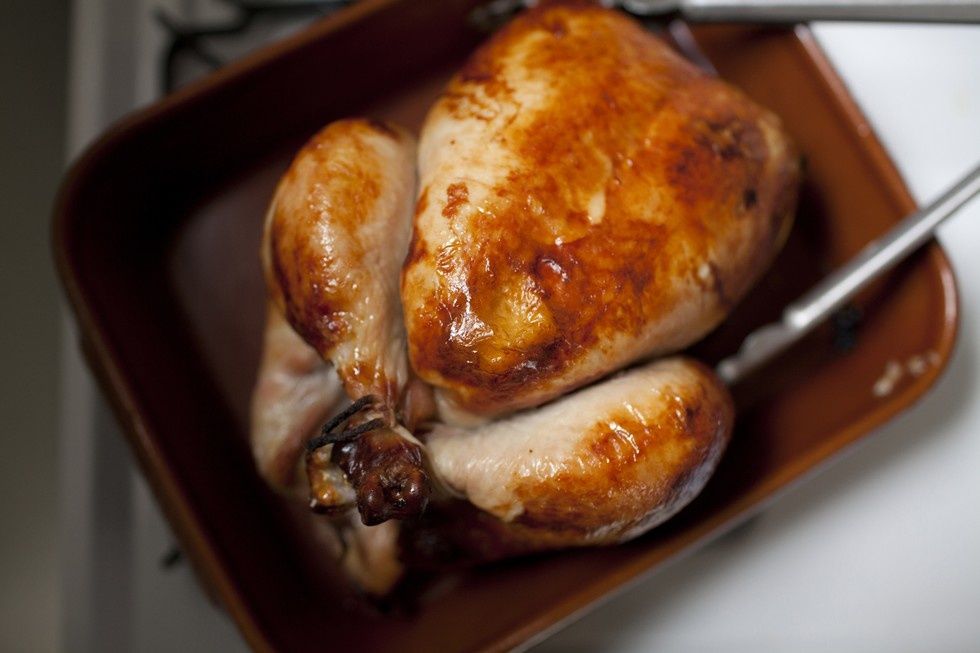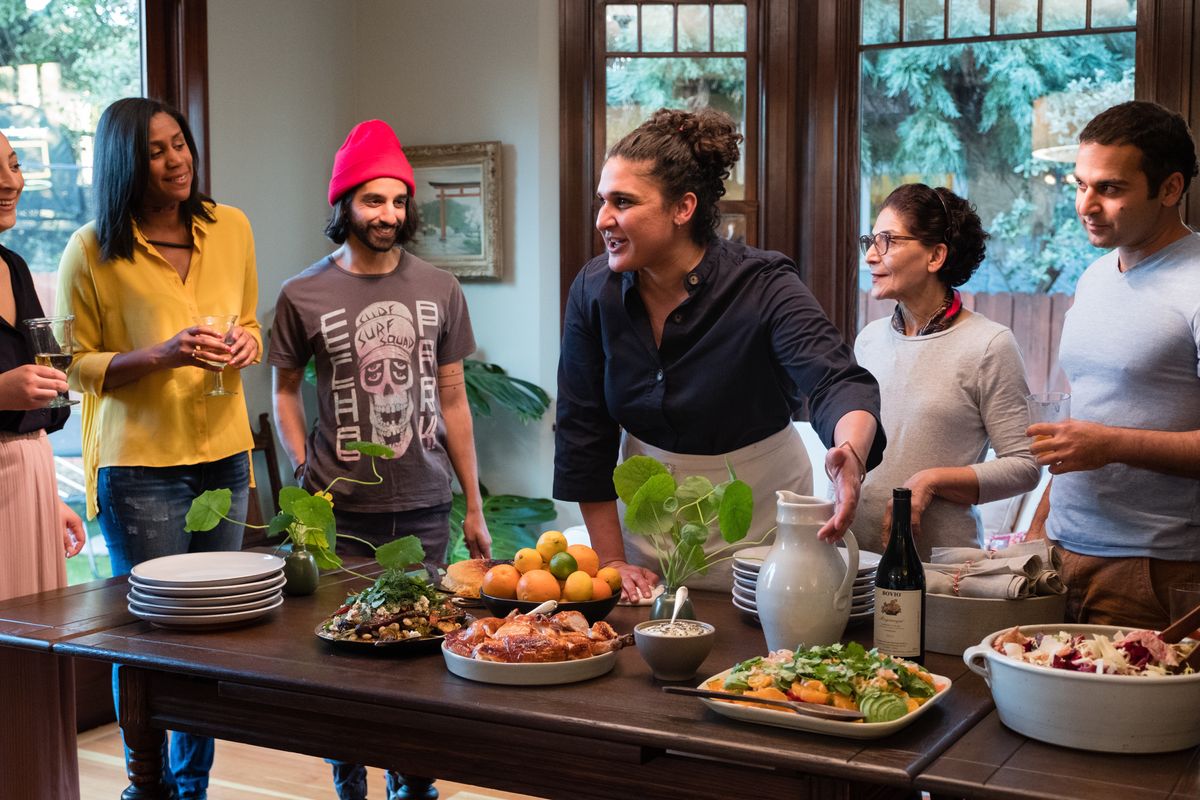I have a few things to be grateful to Samin Nosrat about.
One, her new Netflix docuseries, in which she travels the globe, from Japan to Mexico, to explore the tenets of her NYT bestselling book Salt Fat Acid Heat, is like an ingredient-based Parts Unknown (RIP Anthony Bourdain).
Two, The aforementioned 450(-ish)-page tome—part cookbook, part memoir, part manifesto, I read it in bed like a novel to glean flavor factoids (did you know blue cheese and honey are sources of acid, despite their non-lip-puckering properties?) as much as personal stories (turns out, her immigrant family's Thanksgiving experiences were not unlike my own).
And, last but not least, three, I'm grateful to have had her as the first guest on 7x7's new podcast, "People Will Talk," of which I am the host. (Hi!) Gracious, ebullient, articulate as she is, she made things easy for this novice podcast host. I'd tee up a topic—say, the relationship between surfing and cooking—and Nosrat, a Berkeley resident and former Chez Panisse chef, would hit it out of the park with her smart insights and good humor.
Samin Nosrat on Instagram: “GUYS I’M ON A BILLBOARD IN TIMES SQUARE 😭😱😭😱😭#saltfatacidheat”
Nosrat, a first-generation American whose parents hail from Iran, has a perspective on food culture that's more inclusive than most, which is like a salve in the country's current divisive state of affairs. In her show, she paints a richly layered picture of the invaluable contributions of foreign lands to America's culinary culture. Women are worshipped not just for their food know-how, but also the heartfelt transmittal of that heritage intel to younger generations, and their natural ability to gather a table together for a meal.
Nosrat's own mother makes a cameo for the Berkeley episode, proudly toting a cheap-ass soup pot from Marshall's, in which she expertly makes tahdig, or Iranian crispy rice, to accompany buttermilk-brined roast chicken and a citrus salad for a dinner party with Nosrat's friends. In the end, the chef gives the viewer multiple entrées (so to speak) to the melting pot of American cuisine. "Making good food accessible is really important to me," she says. "Maybe, eventually, they'll pass that kindness onto others."
Listen to our full interview with Samin Nosrat on 7x7's podcast, "People Will Talk."
Bonus Recipe: Samin Nosrat's Buttermilk-Marinated Roast Chicken

Ingredients (serves 2-4)
1 whole 4-pound chicken, cleaned (organs removed) and patted very dry
Kosher salt
1 quart buttermilk, well shaken
Any mixture of sliced green garlic, onions, parsnips, carrots, or other root vegetables (just to put at the bottom of the pan), cut into 1/4-inch pieces
Olive oil
2 bay leaves
Spicy French mustard such as Roland (optional)
1. Forty-eight hours before you want to eat this chicken, salt it aggressively. That means using at least a few tablespoons, if not more. The reason is that much of the salt will get washed off by the buttermilk, so here you're helping the inside of the chicken get seasoned. Put the chicken in a covered container and refrigerate overnight.
2. Twenty-four hours later, place the chicken in a re-sealable plastic bag and fill the bag with the buttermilk.
3. Seal it, squish the buttermilk all around the chicken, place on a rimmed plate, and refrigerate. If you're so inclined, over the next 24 hours you can turn the bag so each part of the chicken gets marinated, but that's not essential.
4. When you're ready to roast, preheat the oven to 475 degrees.
5. Add a layer of vegetables to a large cast-iron skillet and coat them with about 1/4 cup olive oil and sprinkle with salt.
6. Remove the chicken from the plastic bag and scrape off as much buttermilk as you can without being obsessive.
7. Place the bay leaves in the chicken's cavity.
8. Truss the chicken by placing a 12-inch length of butcher's twine with its center in the small of the chicken's back. Tie the twine around each wing tightly and then flip the chicken over and use the remaining twine to tie the legs together as tight as you can.
9. Place the chicken on top of the vegetables and drizzle it with a little more olive oil.
10. Place the pan in the oven with the legs pointing toward the back left corner and close the door. You should hear the chicken sizzling pretty quickly.
11. Roast for 15 to 20 minutes. When the chicken starts to brown, lower the heat to 425 degrees and continue roasting for 30 minutes and then move the pan so the legs are facing the back right corner of the oven.
12. Continue cooking for another 30 minutes or so, until the chicken is brown all over and the juices run clear when you cut between the leg and the thigh.
13. When the chicken's done, remove it to a platter and let it rest for 10 to 15 minutes before carving it. Serve with the roasted vegetables and, if you like it, spicy French mustard.
Note:
When you make fried chicken, sometimes you soak it in buttermilk the night before to tenderize it. The same concept applies here, except instead of frying the chicken, you're going to roast it whole. And the finished chicken—which before it was soaked in buttermilk, was seasoned aggressively with salt—will be delectably tender and moist and packed with flavor. Take heed, though: because of all that buttermilk, the chicken will bronze in patches at first (places where the buttermilk soaked in more thoroughly) and then turn a deep brown color, almost like a Thanksgiving turkey. If that happens too fast or it gets too dark, simply cover the darkest spots with foil. It will still taste wonderful.
Excerpted from Secrets of the Best Chefs by Adam Roberts (Artisan Books). Copyright © 2012.
Listen to 7x7's Fall 2018 interview with Samin Nosrat on our podcast, "People Will Talk."





















